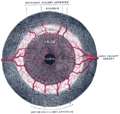| Ciliary muscle | |
|---|---|
 | |
| Details | |
| Pronunciation | UK: /ˈsɪliəri/ , US: /ˈsɪliɛri/ [1] |
| Origin | 1) longitudinal fibers → scleral spur; 2) circular fibers → encircle root of iris [2] |
| Insertion | 1) longitudinal fibers → ciliary process, 2) circular fibers → encircle root of iris [2] |
| Artery | Long posterior ciliary arteries |
| Vein | Vorticose veins |
| Nerve | Short ciliary Parasympathetic fibers in the oculomotor nerve (CN-III) synapse in the ciliary ganglion. Parasympathetic postganglionic fibers from the ciliary ganglion travel through short ciliary nerves into the ocular globe. |
| Actions | 1) Accommodation, 2) regulation of trabecular meshwork pore sizes |
| Identifiers | |
| Latin | musculus ciliaris |
| TA98 | A15.2.03.014 |
| TA2 | 6770 |
| FMA | 49151 |
| Anatomical terms of muscle | |
The ciliary muscle is an intrinsic muscle of the eye formed as a ring of smooth muscle [3] [4] in the eye's middle layer, the uvea (vascular layer). It controls accommodation for viewing objects at varying distances and regulates the flow of aqueous humor into Schlemm's canal. It also changes the shape of the lens within the eye but not the size of the pupil [5] which is carried out by the sphincter pupillae muscle and dilator pupillae.
Contents
- Structure
- Development
- Nerve supply
- Function
- Accommodation
- Trabecular meshwork pore size
- Clinical significance
- Glaucoma
- History
- Etymology
- Additional images
- See also
- References
- External links
The ciliary muscle, pupillary sphincter muscle and pupillary dilator muscle sometimes are called intrinsic ocular muscles [6] or intraocular muscles. [7]



